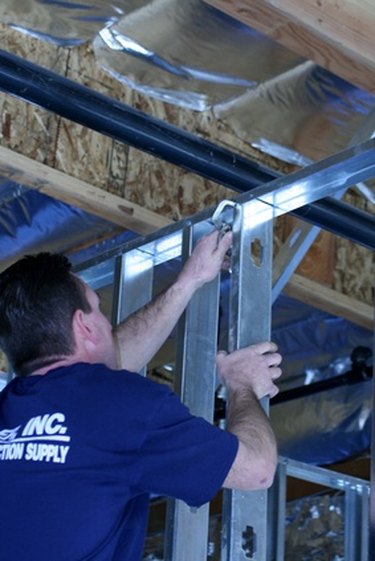Things You'll Need
Zircon StudSensor
Pencil
Level

The Zircon StudSensor locates the edge of wood and metal studs behind drywall. It is used to find a stud so you can securely mount items such as pictures or flat-screen televisions to a wall or anchor large pieces of furniture. It works by locating the edge of metal or wood studs through a depth of up to 3/4 inch. It also has a sensor that lets you know when you've begun your search over a stud, beeping and lighting to let you know you need to start again.
Step 1
Turn the StudSensor on while facing it away from a wall. Bring your hand to the back of the StudSensor. If the LEDs light as your hand is brought up to the back, then it is working properly.
Video of the Day
Step 2
Check that the StudSensor is off and then place it flat with its back against the surface of the wall.
Step 3
Press the "On/Off" button and hold it. Wait for the LED to light to indicate the stud finder is on.
Step 4
Slide the Zircon StudSensor slowly across the wall horizontally (left or right). As you approach a stud, the red LEDs will light from bottom to top. The green LED will light, and a beep will sound when you've found the edge of a stud.
Step 5
Mark the edge of the stud when the green light indicates you've found it.
Step 6
Slide the stud finder past the marked stud edge until the LED lights go out.
Step 7
Move the StudSensor in the opposite direction to find the other edge of the stud. The red lights will light as they did before. When the green light is illuminated and the StudSensor beeps, you've found the other end of the stud.
Step 8
Mark the edge of the stud as indicated by the stud finder.
Step 9
Place a level on the wall to mark the middle of the stud: This is the center point between the two marks you've made.
Tip
The Zircon StudSensor is intended for indoor use on dry walls only. Moisture, wall thickness, and density can affect the sensing depth.
The Zircon StudSensor is not intended to scan inconsistent densities like ceramic tile, carpeting, wallpaper that contains metallic fibers, painted walls that are still wet, or lath and plaster walls.
If the unit doesn’t sense a stud, try moving it to the left or right and turn the unit off and on to start again.
If the surface you are scanning is rough, place a piece of cardboard on the wall and run the stud finder over the cardboard.
Always hold the Zircon StudSensor parallel to studs and move it across from left to right.
Studs are typically spaced 16 inches apart. Be cautious of nailing into anything that the StudSensor indicates at a different width. Studs are normally only 1 1/2 inches in width. Anything measuring a different width may not be a stud or joist.
If the lights blink and the StudSensor beeps repeatedly, you may be in an area where there are no studs. Move the unit and start again and make sure it is flat against the wall. Electrical wiring and pipes near the surface of the wall will also cause the unit to beep and the lights to flash.
Video of the Day